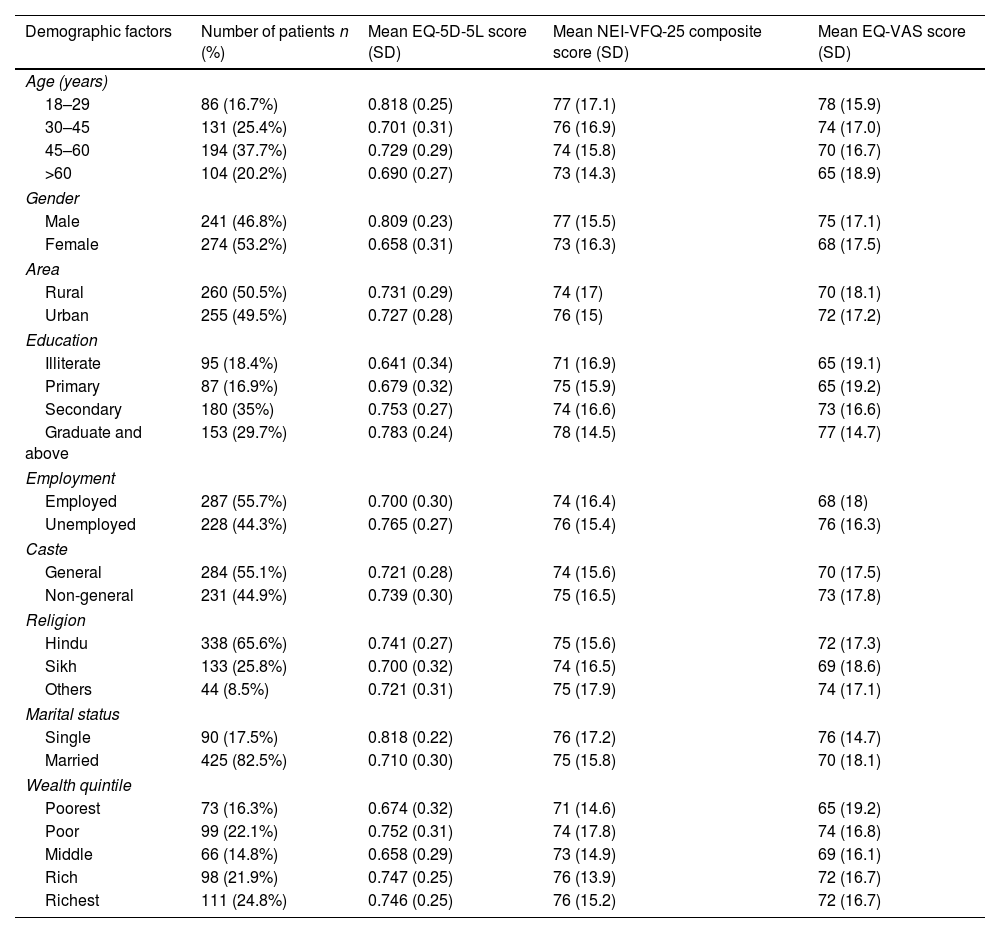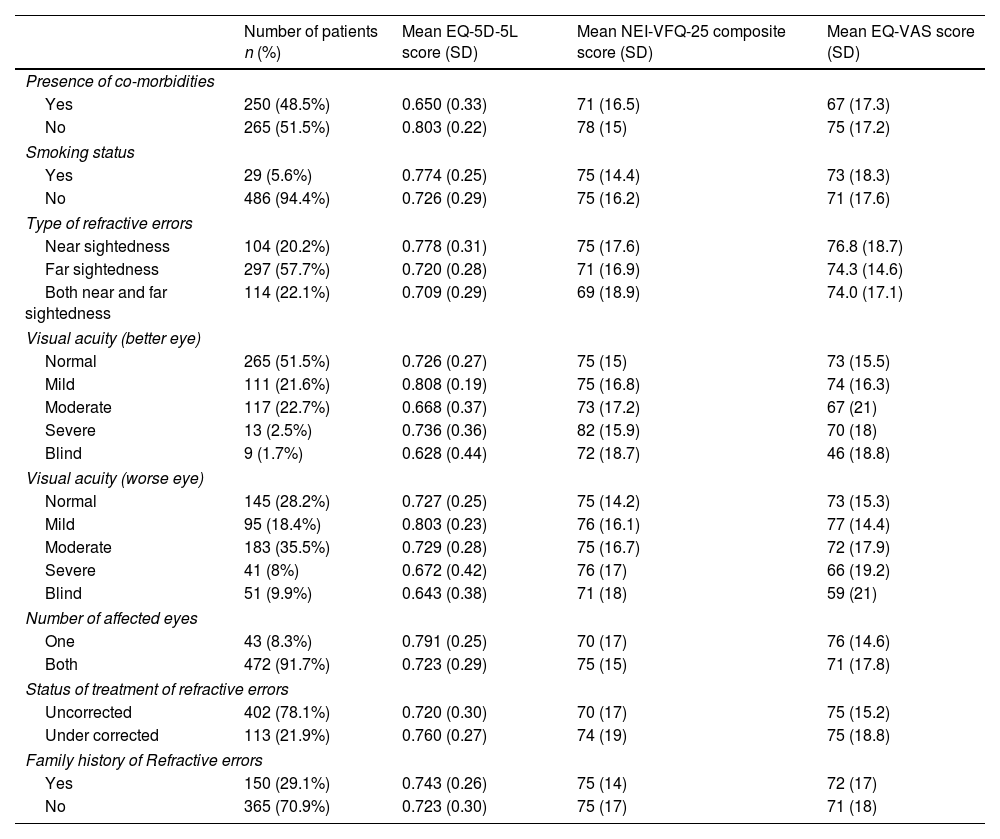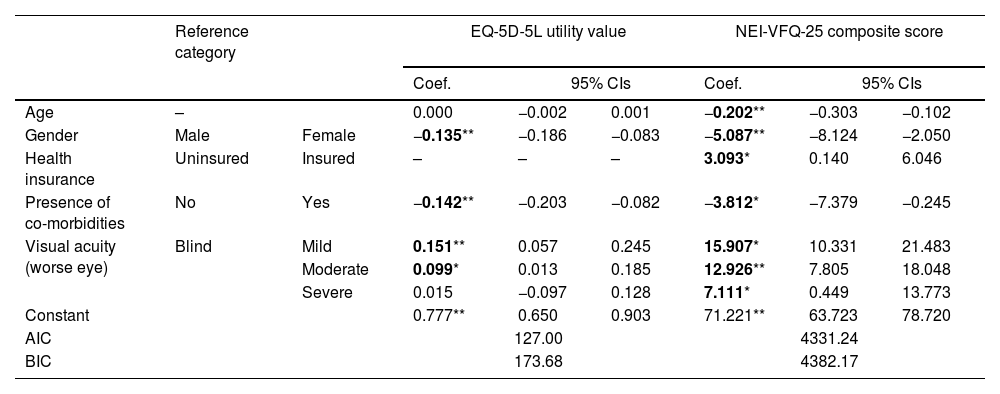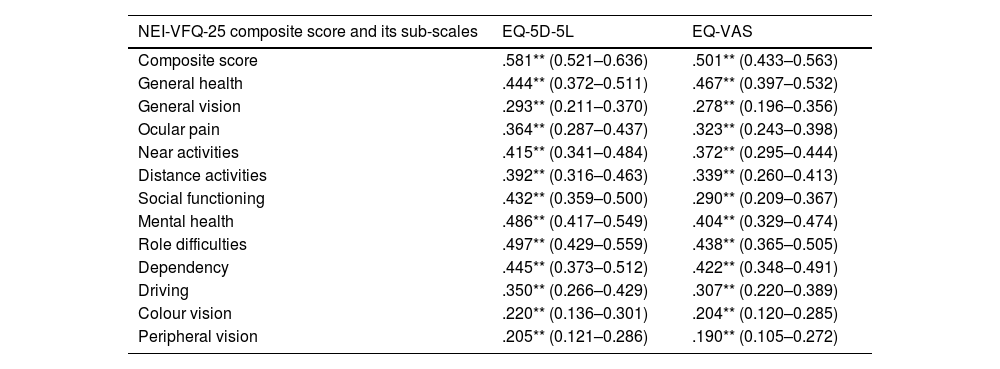It is important to determine the health-related quality of life (HRQoL) to devise population-based cost-effective service delivery models. The present study aimed to evaluate the HRQoL of patients with refractive errors (RE) using generic and vision-specific instruments, identify the determinants of HRQoL, and examine the validity between the quality-of-life instruments for refractive errors.
MethodsFace-to-face interviews were conducted with 515 participants with RE using generic as well as vision-specific HRQoL measures. Mean EuroQol-five dimensions-five levels (EQ-5D-5L) utility value, National Eye Institute-Visual Function Questionnaire-25 (NEI-VFQ-25) composite score, and EuroQol-Visual analogue scale (EQ-VAS) score were computed, and determinants of quality of life were determined using generalized linear regression model. The validity between generic and disease-specific measures was ascertained using Pearson's coefficient.
ResultsThe mean EQ-5D-5L utility score for patients with RE was estimated as 0.72 (95% CI: 0.70–0.75). The mean NEI-VFQ-25 composite score and EQ-VAS score were 71.3 (95% CI: 69.8–73), and 74.7 (95% CI: 73.4–76.1), respectively. Visual acuity, gender, and presence of co-morbidities were significantly associated with quality of life. The concurrence between the generic and vision-specific instruments was found to be low to moderate.
ConclusionThe findings of the study indicate the importance of the value of quality of life for patients with RE, which could be taken into account by health administrators, doctors and researchers to carry out economic evaluations, since these measures provide a basis for an evaluation more precisely the impact of RE and guide the determination of efficient ways to alleviate the burden of treatable visual impairment.
More research is required to explore the potential integration of a vision component, the sixth dimension, into the EQ-5D-5L instrument, given the moderate agreement observed between the generic and specific assessment tools.
Es importante determinar la calidad de vida relacionada con la salud (CVRS) para diseñar modelos de prestación de servicios rentables basados en la población. El presente estudio tuvo como objetivo evaluar la CVRS de los pacientes con errores refractivos (ER) utilizando instrumentos genéricos y específicos de la visión, identificar los determinantes de la CVRS y examinar la validez entre los instrumentos de calidad de vida para ER.
MétodosSe realizaron entrevistas cara a cara con 515 participantes con ER utilizando medidas de CVRS tanto genéricas como específicas de la visión. Se calculó el valor medio de utilidad del EuroQol-cinco dimensiones-cinco niveles (EQ-5D-5L), la puntuación compuesta del Cuestionario Nacional del Instituto del Ojo de Función Visual-25 (NEI-VFQ-25) y la puntuación de la escala analógica visual del EuroQol (EQ-VAS), y se definieron los determinantes de la calidad de vida utilizando un modelo de regresión lineal generalizado. La validez entre las medidas genéricas y específicas de la enfermedad se determinó utilizando el coeficiente de Pearson.
ResultadosEl puntaje medio de utilidad del EQ-5D-5L para pacientes con ER se estimó en 0,72 (IC 95%: 0,70-0,75). La puntuación compuesta media del NEI-VFQ-25 y la puntuación EQ-VAS fueron 71,3 (IC 95%: 69,8-73) y 74,7 (IC 95%: 73,4-76,1), respectivamente. La agudeza visual, el género y la presencia de comorbilidades se asociaron significativamente con la calidad de vida. La concordancia entre los instrumentos genéricos y específicos de la visión fue de baja a moderada.
ConclusiónLos hallazgos del estudio indican la importancia del valor de la calidad de vida para los pacientes con ER, que podrían ser tenidas en cuenta por la administración sanitaria, los médicos y los investigadores para realizar evaluaciones económicas, pues estas medidas proporcionan una base para una evaluación más precisa del impacto de las ER y guían la determinación de formas eficientes de aliviar la carga de la discapacidad visual que es tratable. Se requiere más investigación para explorar la potencial integración de un componente referido a la visión, la sexta dimensión, en el instrumento EQ-5D-5L, dado el moderado acuerdo observado entre las herramientas de evaluación genéricas y específicas.












